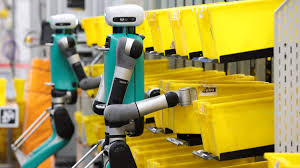A New Era in Robotics: The World’s First Humanoid Robot Factory
Agility Robotics' RoboFab is the World's First Humanoid Robot Factory, producing robots like Digit to address workforce challenges, improve efficiency, and offer new learning opportunities in robotics and AI for students.


The future of robotics has arrived with the opening of RoboFab, the world’s first humanoid robot factory in Salem, Oregon, led by Agility Robotics. This milestone marks a significant shift in how we think about automation and labor, with the potential to reshape industries ranging from manufacturing to logistics.
When and Why Was the Factory Built?
Construction of RoboFab began in 2022 and is set to become fully operational in 2024, with plans to produce thousands of humanoid robots annually by 2025. The vision behind this endeavor stems from the increasing demand for automation to address challenges in the modern workforce, such as labor shortages, high turnover, and workplace injuries. The factory’s primary product, Digit, is a humanoid robot designed to handle physically demanding tasks typically performed by humans, such as lifting, loading, and material handling in warehouses【source】.
Agility Robotics, co-founded by Damion Shelton, has built this factory to mass-produce robots that can alleviate pressures faced by industries worldwide. The goal is to not just automate, but to augment human capabilities in environments where humans and robots work side by side【9†source】.
The Benefits of Humanoid Robots
Humanoid robots like Digit offer numerous advantages, especially in industries that rely on physical labor. First, they are designed to fit seamlessly into environments built for humans. This means they can navigate spaces such as warehouses and distribution centers without significant alterations to existing infrastructure. Digit’s human-like form allows it to safely and efficiently handle tasks such as moving boxes or unloading trucks【source】.
The ability to work autonomously for long shifts—up to 16 hours a day—makes Digit an invaluable tool in addressing labor shortages, especially in sectors with repetitive, physically taxing work [source]. For companies, this could mean higher efficiency, lower operational costs, and fewer workplace injuries.
Moreover, RoboFab will not only produce robots but also employ hundreds of skilled workers. This is a crucial step in creating high-skilled job opportunities in regions like Salem, contributing to both local economies and the broader robotics industry【source】.
Potential Drawbacks and Concerns
Despite the many advantages, there are potential drawbacks to humanoid robots that must be considered. For one, the initial investment required to adopt such advanced technology could be high, which may be a barrier for smaller businesses. Additionally, concerns about job displacement in industries with heavy automation may arise, particularly in sectors where humans have traditionally performed manual labor.
Another concern is the current limitations of robotic technology. While Digit is highly effective in environments like warehouses, its functionality is still relatively narrow, focusing mainly on tasks such as moving and lifting. The technology has not yet evolved to the point where robots can handle complex decision-making or intricate tasks that require fine motor skills【source】.
How This Technology Impacts Learning for Students
For students, particularly those interested in STEM (Science, Technology, Engineering, and Mathematics) fields, the rise of humanoid robots like Digit represents a massive opportunity. As robotics and AI become more integrated into the workforce, the need for education in these fields is more critical than ever. Students can explore the design, programming, and ethical considerations of working alongside intelligent machines.
Agility Robotics has already begun collaborating with educational institutions to create learning opportunities for students in engineering, AI, and robotics. The factory will serve as a hub for innovation, offering insights into cutting-edge manufacturing techniques and human-robot collaboration【source】.
By witnessing the production and real-world applications of humanoid robots, students will have a first-hand look at how these technologies shape the future. In addition to technical skills, the presence of humanoid robots in workplaces will also prompt discussions around human-robot interaction, ethics, and the societal implications of automation.
Conclusion
The launch of RoboFab, the world’s first humanoid robot factory, marks a transformative moment in the evolution of robotics and labor. With the potential to revolutionize industries, improve workplace safety, and open up new educational avenues, the mass production of humanoid robots like Digit offers significant benefits and challenges. As we move forward, this groundbreaking innovation will undoubtedly reshape how we view the role of robots in everyday life, making it crucial for businesses, workers, and students to adapt and embrace this future.
